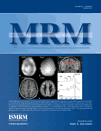Simultaneously driven linear and nonlinear spatial encoding fields in MRI
Abstract
Spatial encoding in MRI is conventionally achieved by the application of switchable linear encoding fields. The general concept of the recently introduced PatLoc (Parallel Imaging Technique using Localized Gradients) encoding is to use nonlinear fields to achieve spatial encoding. Relaxing the requirement that the encoding fields must be linear may lead to improved gradient performance or reduced peripheral nerve stimulation. In this work, a custom-built insert coil capable of generating two independent quadratic encoding fields was driven with high-performance amplifiers within a clinical MR system. In combination with the three linear encoding fields, the combined hardware is capable of independently manipulating five spatial encoding fields. With the linear z-gradient used for slice-selection, there remain four separate channels to encode a 2D-image. To compare trajectories of such multidimensional encoding, the concept of a local k-space is developed. Through simulations, reconstructions using six gradient-encoding strategies were compared, including Cartesian encoding separately or simultaneously on both PatLoc and linear gradients as well as two versions of a radial-based in/out trajectory. Corresponding experiments confirmed that such multidimensional encoding is practically achievable and demonstrated that the new radial-based trajectory offers the PatLoc property of variable spatial resolution while maintaining finite resolution across the entire field-of-view. Magn Reson Med, 2011. © 2010 Wiley-Liss, Inc.




